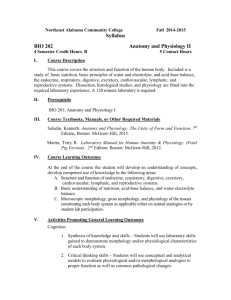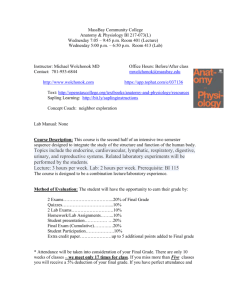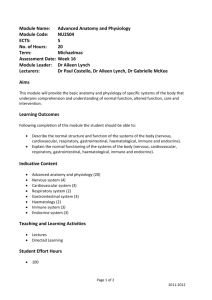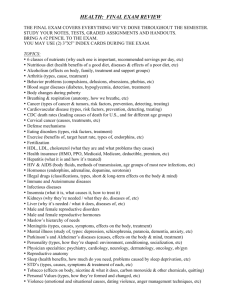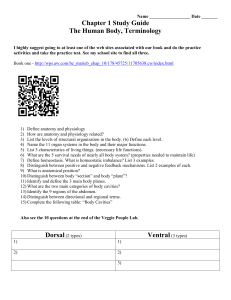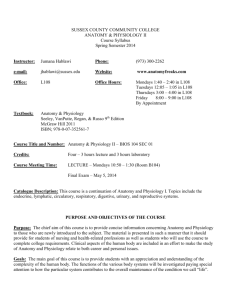RU Anatomy Physiology Two - Rutgers: School of Health Related
advertisement
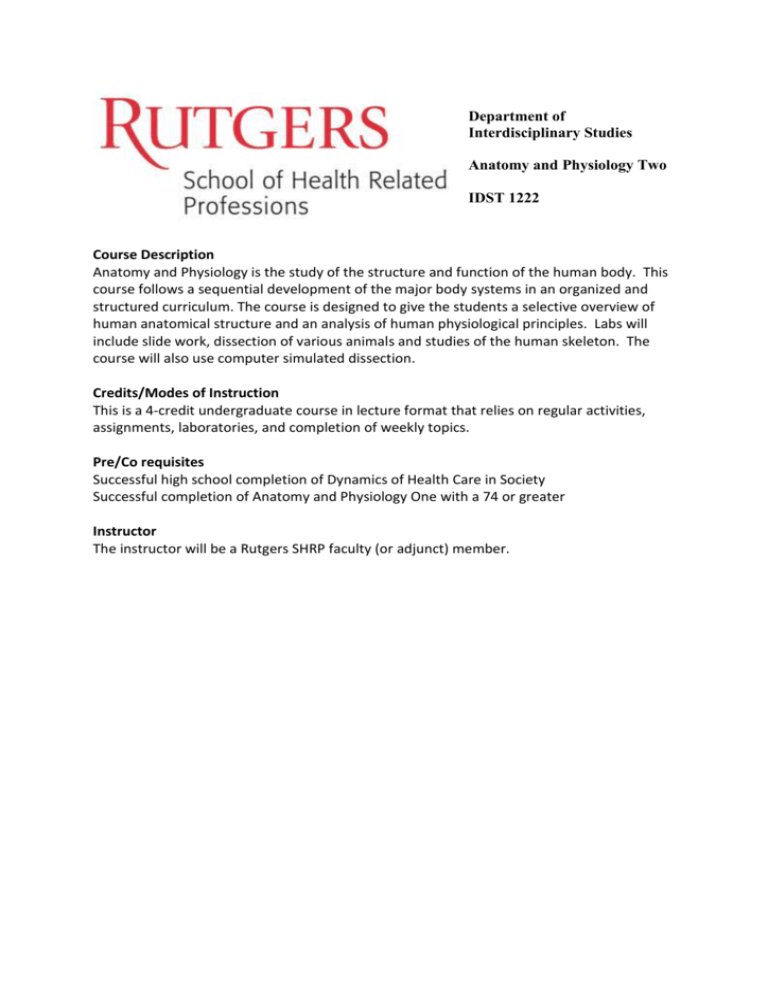
Department of Interdisciplinary Studies Anatomy and Physiology Two IDST 1222 Course Description Anatomy and Physiology is the study of the structure and function of the human body. This course follows a sequential development of the major body systems in an organized and structured curriculum. The course is designed to give the students a selective overview of human anatomical structure and an analysis of human physiological principles. Labs will include slide work, dissection of various animals and studies of the human skeleton. The course will also use computer simulated dissection. Credits/Modes of Instruction This is a 4-credit undergraduate course in lecture format that relies on regular activities, assignments, laboratories, and completion of weekly topics. Pre/Co requisites Successful high school completion of Dynamics of Health Care in Society Successful completion of Anatomy and Physiology One with a 74 or greater Instructor The instructor will be a Rutgers SHRP faculty (or adjunct) member. Course Objectives Upon completion of this course the student will be able to: 1. 2. 3. 4. 5. 6. 7. Utilize the language of anatomy to describe levels of structural organization and example of homeostasis to all body systems, Apply basic concepts of chemistry and biochemistry to all body systems. Identify microscopic structures of all body systems as presented in the lab. Identify and explain the structure and function of the major body systems and explain their interrelationships with one another in maintaining homeostasis. Identify and locate gross structures of the human anatomy. Develop dissection and lab skills with awareness of infection control and safety. Compare and contrast normal and abnormal characteristics and functions of the body. Teaching Suggestions 1. Teacher lecture, followed by discussion. 2. Students read text, followed by discussion. 3. Students view audio-visual material, followed by discussion. 4. Students complete computer software program assignments, when available. a. Body Illustrated, IBM b. Body Works, IBM c. Adam, IBM d. Dr. Know-It-All, Body Works, MAC e. VH Dissector Pro 5. Students read articles, pamphlets and case assignments followed by class discussion. 6. Students view and make posters, followed by class discussion. 7. Guest speakers when appropriate. 8. Related field trips when appropriate. 9. Individual discussion. 10. Written and photocopied notes. 11. Written and oral testing. Methods of Student Evaluation Student evaluation will be based on but not limited to the following factors: 1. 2. 3. 4. 5. 6. Student proficiencies Attendance Class Preparation Class Participation Completion of assignments including class work, homework, tests and lab assignments. Fulfillment of other responsibilities as stated by individual instructors. i.e. Student contract, dated and signed. Grade Determination The minimum level of satisfactory performance in this course is a ‘C’ or better. To receive a ‘C’ or better, students must first complete ALL course requirements specified above, including meeting the minimum attendance expectation. Upon successful completion of the course at the high school students will be eligible to take the Rutgers School of Health Related Professions, Health Science Careers standardized exam to determine college credit. For Anatomy and Physiology 2 - 50% of standardized exam grade + 50% high school grade = Rutgers School of Health Related Professions grade as listed on Rutgers SHRP transcript. All students must attain a C (74) or better to earn college credits. Minimum passing standardized exam grade must be at least 70 before calculations of college transcript grade can be determined. Health Science Careers Program Grading System Weighted Average of All Requirements Final Letter Grade 94-100 A 90-93 A- 87-89 B+ 84-86 B 80-83 B- 77-79 C+ 74-76 C Unsatisfactory Performance/Progress Unsatisfactory performance which may include late assignments, failing grades, and/or attendance or progress problems will be discussed individually on an as needed basis. Honor Code and Academic Integrity (Refer to your SHRP Student Handbook at http://shrp.rutgers.edu/current_students/handbook.pdf) The faculties of Rutgers School of Health Related Professions believe that students must observe and support high standards of honesty and integrity. For this reason, all students in this course are expected to abide by the School's Honor Code and uphold its Code of Academic Integrity. As described in detail in your Student Handbook, violations of the Code of Academic Integrity include cheating, plagiarism, fabrication and/or academic misconduct. All such violations will be considered with gravest concern and may be punishable with sanctions as severe as suspension or dismissal. If you have not previously affirmed the School's Honor Code (either in writing or electronically), you must submit a signed and dated copy of the Honor Code to the instructor by the end of the first week of the semester. The Honor Code form is provided in the current SHRP Student Handbook. General Learning Resources Textbooks References Hole’s Human Anatomy and Physiology David Shier Jackie Butler Ricki Lewis Wm. C. Brown/McGraw Hill Publishers Essentials of Human Anatomy and Physiology Hole, J.W. Wm. C.Brown Publishers Principals of Anatomy and Physiology Tortora, G.J. and Grabowski, S.R. HarperCollins College Publishers, Inc. Human Form, Human Function Thomas H. McConnell Kerry L. Hull Wolters Kluwer, Lippincott Williams & Wilkins Human Anatomy and Physiology Marieb, E.N. The Benjamin/Cummings Publishing Company, Inc. Fundamentals of Anatomy and Physiology Martini, F. Prentice Hall Anatomy and Physiology The Unity of Form and Function Kenneth S. Saladin Wm. C. Brown/McGraw Hill Publishers Essentials of Anatomy and Physiology Valerie C. Scanlon Tina Sanders F.A. Davis Requirements for Anatomy and Physiology Two The study of the structure and function of the human body is necessary as a basic science prerequisite. This will prepare the student for all other basic science and clinical courses. This introductory course includes lectures and lab components of Anatomy and Physiology Two. The Endocrine system unit should be included as part of all other systems. OUTLINE: 1. 2. 3. 4. 5. 6. 7. 8. 9. 10. Endocrine System Lymphatic System Blood Cardiovascular System Respiratory System Digestive System Urinary System Water and Electrolyte Balance Female Reproductive System Male Reproductive System Anatomy and Physiology 2 Course Outline I. Endocrine System A. Functions of Endocrine Glands and Hormones B. Mechanisms of Hormone Actions C. Control of Hormone Secretions D. Growth Factors E. Stress and Its Effects F. Clinical Applications G. Medical Terminology II. Digestive System A. Digestive Processes B. Anatomy of Digestive Tract C. Physiology of Chemical Digestion D. Regulation of Digestive Secretions E. Physiology of Absorption F. Basal Metabolism G. Disorders: Homeostatic Imbalances H. Clinical Applications G. Medical Terminology III. Respiratory System A. Organs of the Respiratory System B. Physiology of Respiration C. Transport and Gas Exchange D. Nervous Control of Respiration E. Disorders: Homeostatic Imbalances F. Clinical Applications G. Medical Terminology IV. Blood A. Functions of Blood B. Blood Composition and Blood Cells C. Blood Plasma D. Formation of Blood Cells E. Anatomy and Physiology of Red and White Blood Cells and Platelet F. Blood Groups G. Disorders: Homeostatic Imbalances H. Clinical Applications H. Medical Terminology V. Cardiovascular System A. Structure of the Heart B. Actions of the Heart C. Blood Vessels D. Blood Pressure E. Path of Circulation F. Arterial and Venous Systems G. Hormonal Involvement H. Disorders: Homeostatic Imbalances I. Clinical Applications J. Medical Terminology VI. Lymphatic System A. Lymphatic Vessels and Lymph Circulation B. Lymph Tissues C. Nonspecific Resistance to Disease D. Immunity and Allergic Reactions E. Disorders: Homeostatic Imbalances F. Medical Terminology VII. Urinary System A. Kidneys and Related Structures/Organs B. Physiology of Urine Formation and Elimination C. Kidney Function D. Disorders: Homeostatic Imbalances E. Medical Terminology VIII. Water, Electrolyte and Acid/Base Balance A. Distribution of Body Fluids B. Water Balance C. Electrolyte Balance D. Acid/Base Balance E. Clinical Applications IX. Female Reproductive System A. Organs of the Female Reproductive B. Parturition C. Hormonal Control of Female Reproductive Factors D. Conception/Birth Control E. Disorders: Homeostatic Imbalances F. Clinical Applications G. Medical Terminology X. Male Reproductive System A. Organs of the Male Reproductive System B. Hormonal Control of the Male Reproductive System C. Disorders: Homeostatic Imbalances D. Clinical Applications E. Medical Terminology Objectives: I. Endocrine System this unit should be taught as part of all other systems. A. On a diagram, identify all the glands and tissues that make up the endocrine system. B. Differentiate between endocrine and exocrine glands. C. Describe the major endocrine glands of the body and list the hormones they secrete. D. Differentiate between the anterior and posterior pituitary gland. E. Define the term hormone and describe the functions of hormones. F. Describe the functions of the hormones secreted by the endocrine glands. G. Describe the transportation process of hormones and their interaction with target cell receptors. H. Discuss how hormones promote homeostasis of the body and give three examples of hormonal actions. I. Describe negative feedback, how it regulates hormonal secretions and give two examples. J. Describe the functional relationship between the hypothalamus and the pituitary gland. K. Differentiate between physical and psychological stress. L. Describe the effects of aging on the endocrine system. M. List and describe disease/disorders associated with the endocrine system. N. Contrast the actions of insulin and glucagon. O. Define important terminology of the endocrine system. II. A. B. C. D. E. F. G. H. Lymphatic System Describe the functions of the lymphatic system. Explain how the lymphatic system is functionally related to the cardiovascular and lymphatic systems. Describe the location of the major lymphatic pathways. Describe the formation and composition of lymph and explain how it is transported through the lymphatic system. Describe a lymph node and its major functions. Locate the major chains of lymph nodes. Describe the functions of the thymus and the spleen. Explain the differences between specific and nonspecific body defenses and provide examples of each defense. I. J. K. L. M. III. Define immunity and describe how T and B cells arise. Explain the relationship between an antigen and an antibody. Explain how allergic reactions and tissue rejection reactions are related to immune mechanisms. List and describe disease/disorders associated with the lymphatic system. Define important terminology of the lymphatic system. E. F. G. H. I. Blood Describe the functions of the lymphatic system. Describe the composition of plasma and discussion its importance in the body. Distinguish between the formed elements found in the blood. Identify the stages involved in blood clotting and explain the various facets that promote and inhibit blood clotting. Explain the basis for blood typing. Describe how blood reactions may occur between the fetal and maternal tissues. Explain the basis f physiological jaundice seen in some newborn babies. List and describe disease/disorders associate with the blood. Define important terminology related to the blood. A. B. C. D. E. F. G. H. I. J. K. L. M. N. Cardiovascular System List the structures of the cardiovascular system and describe their functions. Identify the major parts of the heart and describe their functions. Describe the flow of blood through the heart. Describe the coronary circulation. Compare the structures and function of arteries, capillaries, and veins. Explain the mechanism that helps in the return of venous blood to the heart. Give the physiological basis for arterial pulse, and describe how pulse is measured. Describe the factors which create and control blood pressure. Define blood pressure and give its relationship to blood flow and resistance. Explain and demonstrate how blood pressure is measured. Contrast the pulmonary and systemic circuits of the cardiovascular system. Trace a drop of blood through the pulmonary and systemic circulations. List and describe diseases/disorders associated with the cardiovascular system. Define important terminology of the cardiovascular system. A. B. C. D. IV. V. A. B. C. D. E. F. G. H. Respiratory System Describe the general functions of the respiratory system. List and describe the structure and organs of the respiratory system. Describe the functions of the structures and organs of the respiratory system. Describe the protective mechanisms in the respiratory system. Describe the events involved in inspiration and preparation. List and describe each of the respiratory air volumes. Outline the types of non-respiratory air movements and describe how each occurs. Explain how the respiratory muscles cause volume changes that lead to air flow into I. J. K. L. M. N. O. P. Q. R. VI. A. B. C. D. E. F. G. H. I. J. K. L. M. O. P. Q. R. S. T. U. VII. and out f the lungs. Describe the process of gas exchanges in the lungs and tissues. Explain how respiratory gasses are carried by the blood. Name the main areas involved in the control of respiration. List three factors that influence respiratory rate. Explain the major events that occur during cellular respiration. Explain how oxygen is used by cells. Trace the breath of air through the respiratory system from nose to alveoli. Describe the symptoms and probable causes of Chronic Obstructive Pulmonary Disease and lung cancer. Describe diseases/disorders associated with the respiratory system. Define important terminology relate to the respiratory system. Digestive System Name, describe and locate the structures and organs of the digestive system. Describe the functions of the digestive system and the liver. Describe the composition and functions of saliva. Describe the basic anatomy of the teeth and oral cavity and explain their functions in the digestive system. Describe the mechanism of swallowing, vomiting, and defecation. Describe the mechanism peristalsis and its role in the G.I. tract. List the enzymes secreted by the various digestive organs and describe the function of each. Explain how gastric secretions are regulated. List and describe the four layers of the wall of the G.I. tract. Describe the structure and function of the liver and gall bladder. Describe the pancreatic structure. List and explain the digestive function of the pancreatic secretions. Describe the structure and function of the small intestine. Describe the structure and function of the large intestine and the rectum. Explain how the processes in the stomach, liver, pancreas, gall bladder, and small intestines are coordinated. Describe the absorption of nutrients in the small intestine. Define enzyme, metabolism, anabolism, and catabolism. List in sequence each structure through which a bite of food passes on its way through the digestive system. List and describe diseases/disorders associated with the digestive system. Define important terminology of the digestive system. Urinary System A, List the structures and organs of the urinary system and describe their general functions. B. Describe the location and the structure of the kidneys. C. Describe the pathway of blood through the major vessels within a kidney. D. E. F. G. H. I. J. Explain how a nephron works and describe how the major parts function. Describe the production of glomerular filtrate and its composition., Describe the factors which affect the rate of glomerular filtration and how it is regulated. Describe the role that tubular re absorption plays in urine formation. Describe the structure of the ureters, urinary bladder, and urethra. List and describe diseases/disorders associated with the urinary system. Define important terminology of the urinary system. VIII. Water, Electrolyte, and Acid/Base Balance A. Describe the various fluid compartments of the body. B. Explain what is meant by water and electrolyte balance and discuss the importance of this balance. C. Explain how electrolytes enter and leave the body and how the input and output of electrolytes are regulated. D. Explain what is meant by acid/base balance. E. Explain the functions of sodium, chloride, potassium, calcium, phosphate, and magnesium and regulation of their concentrations. F. List the major sources of hydrogen used in the body. G. Compare the role of buffers, exhalation of carbon dioxide, and kidney excretion of h+ in maintaining pH of body fluids. H. List and describe disease/disorders associated with fluid, acid/base and electrolyte balance. I. Define important terminology related to fluid, electrolyte, and acid/base homeostasis. IX. A. B. C. D. E. F. G. H. I. J. K. L. M. Female Reproductive System State the functions of the female reproductive system. List the parts of the female reproductive system and describe the functions of each part. Describe the structure of the ovary and how egg cells and follicles are formed, Describe the role that hormones play in control of the female e reproductive system and in the development of secondary sexual characteristics. List the major events that occur during the menstrual cycle. Describe the process of fertilization and identify the time of the menstrual cycle at which sexual intercourse is most likely to result in pregnancy. Describe the major events of pregnancy. Describe the functions of the amnion and placenta. Describe the stages of birth and role that hormones play in this process. Describe the structure and function of mammary glands. Identify several methods of birth control and evaluate the effectiveness if each method. Explain the symptoms and causes of sexually transmitted diseases. List and describe diseases/disorders associated with the female reproductive N. X. A. B. C. D. E. F. G. H. I. system. Define important terminology of the female reproductive system. Male Reproductive System State the function of the male reproductive system. List the parts of the male reproductive system and describe the function of each part. Name the endocrine and exocrine products of the testes. Discuss the importance of semen and name the glands that produce it. Describe the structure of sperm and relate the structure to its function. Trace the pathway followed by sperm from the testes to the exterior of the body. Explain the symptoms and causes of sexually transmitted diseases. List and describe diseases/disorders associated with the male reproductive system. Define important terminology related to the male reproductive system.
